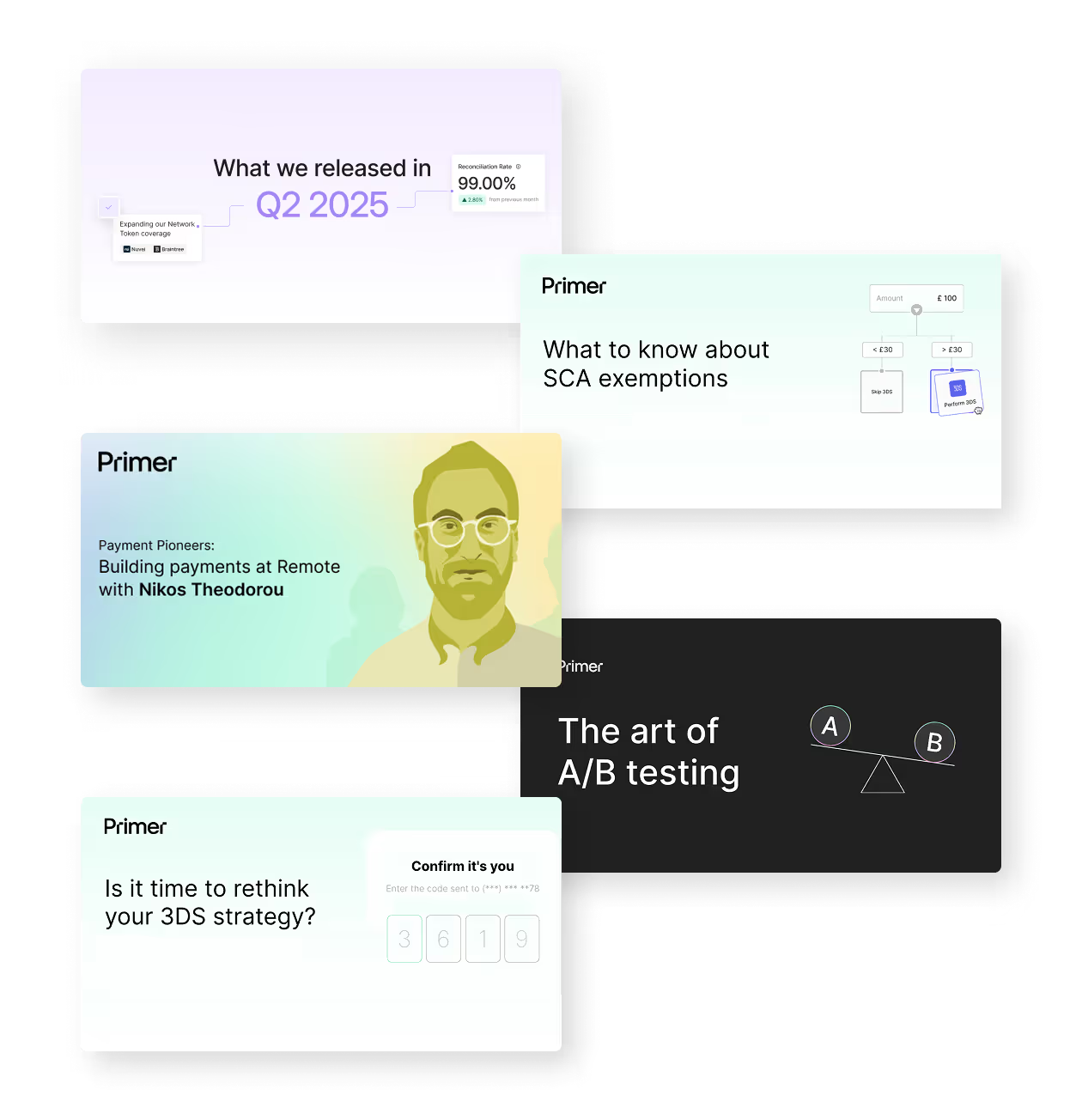You must accept card payments if you're selling goods and services online. There are few, if any, exceptions.
That's because, despite the rise of alternative payment methods over the past decade, cards still account for the lion's share of online transactions. Not accepting card payments at checkout will undoubtedly impact your conversion rates and revenue.
But while you may accept card payments, are you fully briefed on how they work? And do you know what steps to take to optimize card payment acceptance for cost and performance?
In this article, we'll demystify the card payment processing lifecycle, spotlighting each step and looking at the parties involved. We'll also briefly discuss how you can use this knowledge of the payment lifecycle to optimize how you process card payments.
What is payment processing?
Simply put, payment processing is the term used to describe the entire cycle of accepting and verifying payment transactions between a buyer and a seller. And, just like a symphony where musicians follow a carefully crafted score, payment processing involves multiple parties completing steps in (hopefully) perfect harmony so that a payment gets approved.
Just 9% of Americans primarily use cash to pay for purchases, according to a 2023 study by Forbes Advisor—the remaining 93% use either a virtual or physical debit or credit card.
Who's involved in the payment processing lifecycle?
As mentioned, the payment processing lifecycle features numerous parties, each with an important role to play. Let's take a look at these players in the card payment lifecycle.
Card issuer
The card issuer (sometimes also an issuing bank) provides (or issues) its customer's credit and debit cards. These cards are typically associated with the three major card networks: Visa, MasterCard, and UnionPay, although they may also display the badge of a domestic card scheme.
Aside from issuing the cards customers use to pay, card issuers play a critical role in the payment process as the ultimate arbitrator, deciding whether to authorize the payment.
Cardholder
The cardholder, which can be an individual or a business, is the authorized user of the card and the party in the payment processing lifecycle making a payment.
Merchant
The merchant is the person or business entity that sells goods or services to the customer.
Acquirer
The acquirer (also known as a merchant acquirer or acquiring bank) supports the merchant in accepting card payments.
At their core, the role of an acquirer is to pass an authorization request to the card network and handle the response from the issuer that flows back up the chain. If the payment is successfully authorized, the acquirer will also help settle the funds between the customer's and the merchant's account.
Over the past decade or so, the role of a merchant acquirer has expanded significantly. They now offer merchants a more comprehensive range of services and have assumed a new name, Payment Service Provider (PSP). Players like Stripe, Adyen, and Checkout.com are examples of the latest generation of merchant acquirers.
Card network
The card networks (also called card schemes) are the rails that power global commerce. The card networks connect both sides of the transaction (the acquirer and the issuer), providing a standardized platform that allows different financial institutions and merchants to interact seamlessly by passing the necessary information back and forth to process the payment.
The card networks also set the rules. They establish rules and standards that govern the usage of their payment cards. These rules help maintain consistency and reliability in transactions, ensuring a smooth experience for cardholders and merchants.
The world's three largest card networks are Visa, Mastercard, and UnionPay. They sit at the center of the payment process flow, connecting the other four parties (cardholder, issuer, acquirer, and merchant) in what's often called a 'four-corner' or 'four-party model.'
Did you know?
In specific scenarios, a financial institution can play the role of both the issuing bank and the acquiring bank. For instance, American Express acts as an issuer and an acquirer simultaneously. This eliminates one of the four corners, resulting in what is known as the 'three-party model.'
The payment processing lifecycle
Now we know who's involved in the payment processing lifecycle, let's look at the actual process itself.
- The customer or merchant initiates payment: The payment journey begins when the customer initiates a payment at the checkout or when the merchant uses the card details on file to start a merchant-initiated transaction.
- An authorization request gets sent: The merchant's payment gateway transmits a request to the merchant's acquirer, also known as a payment processor. This request includes all the essential data required to support the transaction. This includes but is not limited to the card information, 3DS data, whether the customer or merchant initiated the transaction, whether it's a recurring payment, and whether the merchant uses a network token.
- The processor routes the request: Upon receiving the request, the acquirer forwards it to the card network associated with the card used for the transaction.
- The card network contacts the issuer: Here, the request undergoes evaluation based on various parameters, including card validity and the availability of funds.
- The issuer decides whether to approve or decline the transaction: If the issuer authorizes transactions, its response includes an authorization code. Conversely, a decline or error code is provided if the payment is declined.
- The issuer sends the transaction status to the processor: The card scheme, responsible for overseeing card transactions, communicates the issuer's decision to the merchant's acquirer.
- The processor relays the transaction status to the payment gateway: The merchant's payment gateway receives confirmation of the issuer's decision from the acquirer. Subsequently, the merchant informs the customer whether the transaction has been successfully authorized or declined.
- Temporary hold and settlement: In the case of approval, a temporary hold is placed on the customer's account. This hold remains until the payment is captured, signifying the funds transfer from the customer's bank to the merchant's account.
Potential step: Authentication: Payment authentication through the 3D Secure protocols is commonplace in online commerce today, especially in Europe and other markets where it's mandated. Typically, authentication occurs before the acquirer routes the request to the card network. However, it can also happen following step five, should the issuer require authentication to authorize the payment.
How to accept card payments effectively
Nowadays, businesses of every size accept credit and debit cards online. But while it's relatively easy to start accepting payments, doing it in the most efficient, cost-effective, and secure way is pretty complex.
Here are some key points you should consider to ensure you're optimizing the way you process card payments:
Take compliance seriously
To create a payment environment that's secure and compliant, you need to follow the Payment Card Industry Data Security Standard (PCI DSS) and Payment Services Directive (PSD2) requirements, among other regulations. Demonstrating compliance helps instill confidence in your customers.
Choose a trusted, reputable payment partner
Failed transactions are costly. By choosing high-performing payment partners, you can maximize successful transactions.
Implement fraud protection measures
Payment fraud trends are constantly evolving, so you must implement robust measures to protect your business and customers. Using a unified payments infrastructure like Primer means you can connect fraud prevention tools to minimize the risk of fraudulent transactions and chargebacks.
Monitor transactions
Blocking fraudsters, not customers, relies on accurate data collection and analysis. Capturing as much data as possible about the buyer and the transaction at the checkout helps you spot suspicious activity.
Scrutinize your payment processing activities
Monitor and review your payment-processing activities to spot issues and areas for optimization. To be as cost-efficient as possible regarding your credit card processing fees, make time to revisit how you process card payments and your chosen partners.
Be open about your refund and chargeback policies
Maintain transparent policies on managing refunds and exchanges that your customers can easily find. This helps prevent misunderstandings and disputes with customers, which can result in them initiating a chargeback with their bank.
Streamline reconciliation and reporting
Implement efficient measures to reconcile and report transactions to help you streamline your accounting and the timely settlement of funds. This will also allow you to spot areas of your payment-processing activities that can be optimized.
Remove barriers to optimization with payment orchestration
Payment orchestration is a hot topic in payments. The solution allows merchants to connect with and use various third-party payment services, without making direct integrations.
While it doesn't technically fit into the flow of funds, payment orchestration is becoming an increasingly popular overlay to the payment lifecycle for merchants seeking best-in-class multi-acquirer processing strategies.
So, how do merchants use a payment orchestration layer to optimize their strategy for processing payments?
Routing and optimization: Merchants using an orchestration platform can easily build smart routing strategies that direct payments through different PSPs based on various static and dynamic conditions. Merchants will do this typically to improve performance or reduce cost. In the last few years, platforms have also begun to introduce AI capabilities to usher in the next generation of intelligent payment routing.
Dynamic response handling: Payment orchestration platforms dynamically handle responses from different payment processors, including approvals, declines, or error messages, to abstract the complexity of working with multiple PSPs and create a single source of truth to action from.
Risk management and fraud prevention: Some orchestration platforms allow merchants to plug risk management solutions into their payment flows.
Compliance and security: Payment orchestration platforms help merchants comply with industry regulations and security standards, such as PCI DSS.
Global payment processing: Payment orchestration simplifies the complexity of cross-border transactions by connecting with acquirers and payment processors worldwide. This simplification means merchants can accept card payments in various currencies and comply with local regulations.
Unified reporting and analytics: Payments data is invaluable, and leveraging payment orchestration gives merchants unified reporting and analytics, revealing insights into transaction data, performance metrics, and customer behavior.
Adaptability to market changes: The payment landscape constantly evolves with new payment methods, regulations, and technologies. Payment orchestration systems allow merchants to easily integrate new payment methods and adjust to changes in the market.
Final thoughts
As the payments landscape advances rapidly, an agile and scalable payment processing strategy is critical for merchants to succeed in today's competitive and fast-paced digital economy.
And, with a unified payment infrastructure Primer, merchants can abstract much of the complexity around card payments and build a world-class payment stack and operation for a fraction of the cost and effort it would do in-house.




(1).png)
.png)